Quick Look
Grade Level: 7 (6-7)
Time Required: 30 minutes
Expendable Cost/Group: US $0.00
Group Size: 2
Activity Dependency: None
Subject Areas: Biology, Data Analysis and Probability, Life Science, Problem Solving, Science and Technology
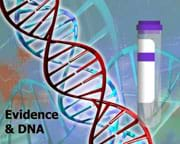
Summary
Students use DNA profiling to determine who robbed a bank. After they learn how the FBI's Combined DNA Index System (CODIS) is used to match crime scene DNA with tissue sample DNA, students use CODIS principles and sample DNA fragments to determine which of three suspects matches evidence obtain at a crime location. They communicate their results as if they were biomedical engineers reporting to a police crime scene investigation.Engineering Connection
Biomedical engineers who understand the science of genetics create tools, equipment and processes to accurately collect and examine DNA evidence for crime and paternity cases. These engineers also work with attorneys and in court systems to explain how DNA profiling works.
Learning Objectives
After this activity, students should be able to:
- Describe the organization of DNA into repeating nucleotide base pair sequences
- Explain how DNA profiling is used to link people to crime and paternity cases.
- Describe the role of biomedical engineering in DNA profiling.
Educational Standards
Each TeachEngineering lesson or activity is correlated to one or more K-12 science,
technology, engineering or math (STEM) educational standards.
All 100,000+ K-12 STEM standards covered in TeachEngineering are collected, maintained and packaged by the Achievement Standards Network (ASN),
a project of D2L (www.achievementstandards.org).
In the ASN, standards are hierarchically structured: first by source; e.g., by state; within source by type; e.g., science or mathematics;
within type by subtype, then by grade, etc.
Each TeachEngineering lesson or activity is correlated to one or more K-12 science, technology, engineering or math (STEM) educational standards.
All 100,000+ K-12 STEM standards covered in TeachEngineering are collected, maintained and packaged by the Achievement Standards Network (ASN), a project of D2L (www.achievementstandards.org).
In the ASN, standards are hierarchically structured: first by source; e.g., by state; within source by type; e.g., science or mathematics; within type by subtype, then by grade, etc.
NGSS: Next Generation Science Standards - Science
-
Conduct an investigation to produce data to serve as the basis for evidence that meet the goals of an investigation.
(Grades 6 - 8)
More Details
Do you agree with this alignment?
-
Use mathematical representations to describe and/or support scientific conclusions and design solutions.
(Grades 6 - 8)
More Details
Do you agree with this alignment?
-
Advances in technology influence the progress of science and science has influenced advances in technology.
(Grades 6 - 8)
More Details
Do you agree with this alignment?
Common Core State Standards - Math
-
Understand that statistics can be used to gain information about a population by examining a sample of the population; generalizations about a population from a sample are valid only if the sample is representative of that population. Understand that random sampling tends to produce representative samples and support valid inferences.
(Grade
7)
More Details
Do you agree with this alignment?
-
Find probabilities of compound events using organized lists, tables, tree diagrams, and simulation.
(Grade
7)
More Details
Do you agree with this alignment?
-
Understand that the probability of a chance event is a number between 0 and 1 that expresses the likelihood of the event occurring. Larger numbers indicate greater likelihood. A probability near 0 indicates an unlikely event, a probability around 1/2 indicates an event that is neither unlikely nor likely, and a probability near 1 indicates a likely event.
(Grade
7)
More Details
Do you agree with this alignment?
International Technology and Engineering Educators Association - Technology
-
Students will develop an understanding of the relationships among technologies and the connections between technology and other fields of study.
(Grades
K -
12)
More Details
Do you agree with this alignment?
-
Advances and innovations in medical technologies are used to improve healthcare.
(Grades
6 -
8)
More Details
Do you agree with this alignment?
State Standards
Colorado - Math
-
Mathematical models are used to determine probability.
(Grade
7)
More Details
Do you agree with this alignment?
-
Explain that the probability of a chance event is a number between 0 and 1 that expresses the likelihood of the event occurring.
(Grade
7)
More Details
Do you agree with this alignment?
-
Find probabilities of compound events using organized lists, tables, tree diagrams, and simulation.
(Grade
7)
More Details
Do you agree with this alignment?
-
Statistics can be used to gain information about populations by examining samples.
(Grade
7)
More Details
Do you agree with this alignment?
Colorado - Science
-
Use direct and indirect observations, evidence, and data to support claims about genetic reproduction and traits of individuals
(Grade
8)
More Details
Do you agree with this alignment?
Materials List
Each group needs:
- Suspect CODIS Analysis Worksheet, one per team
- pen or pencil
- (optional) scissors
Worksheets and Attachments
Visit [www.teachengineering.org/activities/view/cub_biomed_lesson09_activity1] to print or download.Pre-Req Knowledge
Familiarity with DNA and its constituent nucleotide base pairs.
Introduction/Motivation
A robbery takes place at a bank. As the thief escapes the building, a security guard grabs one of the bank robber's gloves. The bank robber leaves the scene in a phone service van. The phone company identifies three employees who may have been in the vicinity of the bank at the time of the robbery. All employees deny robbing the bank. Can you think of some way, besides witness testimony, that the bank robber could be identified from among the three individuals?
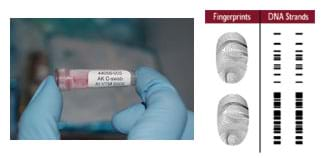
DNA can identify people — even better than fingerprints. DNA is found in all of our cells: hair, teeth, bones, blood and skin. Though all humans share 99.9% of their genes, our DNA differs from everyone else's by three million nucleotide base pairs.
Our DNA is organized in 23 chromosomes in the nucleus in each of our cells. Regions in each chromosome contain what are called "junk DNA," which does not contain genes. But often, this junk DNA contains repeating nucleotide base pair sequences that can be used for matching purposes. (Show students Figure 1 or the same image in the attached CODIS Visual Aid.) In this example, you can see chromosome locations where the FBI looks for repeating sequences of DNA. They're called CODIS sites, which stands for the FBI's Combined DNA Index System.
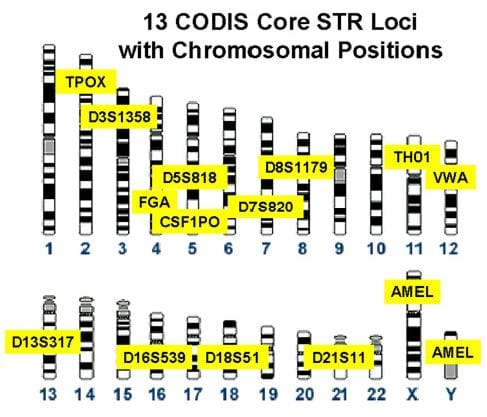
In our case, the police found a hair in the bank robber's glove. Remember that we have 23 pairs of chromosomes, each pair containing one chromosome from our father, the other from our mother. A DNA analysis shows that the hair in the robber's glove contains the following nucleotide base pair sequences in the TPOX region (show students Figure 2 or the same image in the attached CODIS Visual Aid).
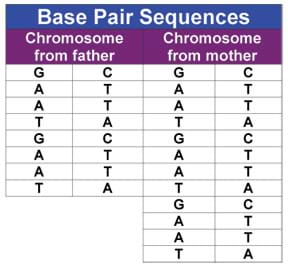
Note that the GAAT sequence is repeated twice in the father's side and three times in the mother's side (the sides of each chromosome are often not the same length). Equivalently, we could say that the CTTA sequence is repeated. Why is that? (G always pairs with C, and A always pairs with T).
So now let's compare the TPOX regions of the DNA found in the bank robber's glove with the TPOX regions of the DNA of two suspects. Note that we are just looking at the one side of the DNA with the GAAT repeating sequence. This simplifies the comparison. (Show students Figure 3 or the same image in the attached CODIS Visual Aid.)
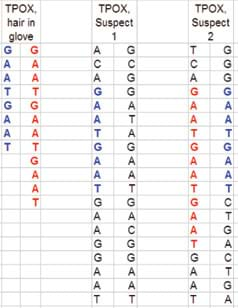
Suspect 1 matches the GAATGAAT sequence of the hair found in the glove on one chromosome, but the other chromosome does not match. Both chromosomes must match to show that the hair in the glove came from a specific suspect. Thus, from just one CODIS site we already know that the hair in the bank robber's glove cannot belong to suspect 1.
Suspect 2 matches the GAATGAAT sequence on one chromosome and the GAATGAATGAAT sequence on the other chromosome, so you can say that suspect 2 matches at the TPOX location. To confirm that the hair belongs to suspect 2, the other 12 chromosome locations (see Figure 1) must also match. If all 13 CODIS locations match, then the hair in the bank robber's glove belongs to suspect 2.
The random probability that one of your CODIS sites matches with someone else's is about one in 10 (1/10). Therefore, the probability of two CODIS sites matching is 1/10*1/10 = 1/100 (one in 100). The chance of three CODIS sites matching randomly is 1/10*1/10*1/10 = (1/10)3 = 1/1000 (one in 1,000). The random chance that all 13 CODIS sites match is (1/10)13 = one in 10,000,000,000,000. The chance of being struck by lightning in your lifetime is, roughly, one in 1,000,000. So you are 10 million times more likely to be struck by lightning than you are to have the same 13 CODIS sequences as another person. This is what makes DNA profiling so certain.
Engineers can be involved in many aspects of crime scene investigation. They might use their knowledge of CAD (computer-aided drawing) to create a reconstruction of the crime scene. First they might develop a model of the room, and then determine the path of bullets and analyze the blood splatter patterns to determine the position of victims and their killers at the time of the crime. Biomedical engineers create the tools, equipment and processes to accurately collect and examine DNA evidence for crime and paternity cases. Biomedical engineers also help investigators with the analysis of the gene sequencing for DNA profiling.
Procedure
Background
In this activity, probability is used to determine which suspect is the most likely match. We are told that the likelihood of a random match between a CODIS site for one person and someone else is 1/10. Why is that? Each of the regions that we are considering here contains an allele, or, a version of a gene. Which allele you have at a particular site is determined by your parents' genetic data and meiosis, as well as any errors in replication. However, these alleles are not unique in a population; you can have the same allele as someone else. Statisticians study populations to get an idea about the distribution of alleles (how many people have each kind of allele). In this way, statisticians can estimate a probability that any two people have the same allele. If the likelihood of a CODIS site match between two random people was much greater or much less than the 1/10 used in this activity, the number of matches we would need in order to be reasonably certain of the suspect's guilt would also change.
Before the Activity
- Make copies of the Suspect CODIS Analysis Worksheet, one per team.
- Set the stage for the activity by conducting the Introduction/Motivation section.
With the Students
- Divide the class into pairs of students, and pass out a worksheet to each team.
- Assist students as they complete their worksheets.
- Have teams conclude by writing on their worksheets which suspect their DNA profiling implicates in the robbery.
- Have the teams with the correct answer describe how they arrived at their conclusion. (Answer: Suspect 2 seems likely based on a match with four CODIS sites).
- Have students calculate the likelihood that suspect 2, even though he matches four CODIS sites, is not the owner of the hair in the bank robber's glove. (Answer: (1/10)4 = 1 in 10,000, not good enough – need more CODIS site data)
- Have students act as biomedical engineers and analyze the results of the DNA profiling for the police investigators as described in the post-assessment activity.
Vocabulary/Definitions
base pair: Two nucleotide bases that form a "rung of the DNA ladder." A DNA nucleotide is made of a molecule of sugar, a molecule of phosphoric acid, and a molecule called a base. The bases are the "letters" that spell out the genetic code. In DNA, the code letters are A, T, G and C, which stand for the chemicals adenine, thymine, guanine and cytosine, respectively. In base pairing, adenine always pairs with thymine, and guanine always pairs with cytosine.
biomedical engineer: A person who blends traditional engineering techniques with the biological sciences and medicine to improve the quality of human health and life. Biomedical engineers design artificial body parts, medical devices, diagnostic tools, and medical treatment methods.
chromosome: One of the threadlike "packages" of genes and other DNA in the nucleus of a cell. Different kinds of organisms have different numbers of chromosomes. Humans have 23 pairs of chromosomes, 46 in all: 44 autosomes plus two sex chromosomes. Each parent contributes one chromosome to each pair, so children receive half of their chromosomes from their mothers and half from their fathers.
CODIS: Acronym for the FBI's DNA identification system: Combined DNA Index System. See: http://www.fbi.gov/hq/lab/html/codis1.htm
CODIS sites: The 13 regions of the chromosomes at which the FBI CODIS looks for repeating DNA sequences for matching purposes.
DNA: Deoxyribonucleic acid contains the genetic instructions that control the biological development of our cells and the proteins the cells make. DNA codes the sequence of the amino acids in proteins using the genetic code, a triplet code of nucleotide bases.
DNA fingerprinting: A method for identifying individuals by the particular structure of their DNA. Because the structure of each person's DNA is different, just like our fingerprints, we can be identified from our DNA. This technique became known to the public as "DNA fingerprinting" because of its powerful ability to discriminate between unrelated individuals.
DNA profile: The result of determining the relative positions of DNA sequences at several locations on the molecule. Each person (except identical twins) has a unique DNA profile when used in the context of the CODIS database, which evaluates 13 specific DNA locations.
engineer: A person who applies his/her understanding of science and math to creating things for the benefit of humanity and our world.
gene: Segments of DNA that get translated into proteins.
junk DNA: Stretches of DNA that do not code for genes; "most of the genome consists of junk DNA." Junk DNA contains repeating base pair sequences that can be used for matching purposes.
nucleotide bases: The parts of RNA and DNA involved in pairing; they include cytosine, guanine, adenine, thymine (DNA) and uracil (RNA), abbreviated as C, G, A, T and U. They are usually simply called bases in genetics. Also called base pairs.
Assessment
Pre-Activity Assessment
Discussion/Brainstorming: As a class, ask students if they can think of some way that a bank robber could be identified if no one saw who he or she was. Remind students that in brainstorming, no idea or suggestion is "silly." All ideas should be respectfully heard. Take an uncritical position, encourage wild ideas and discourage criticism of ideas. Brainstorming is how engineers come up with creative ideas. Have them raise their hands to respond. Record their ideas on the board.
Activity Embedded Assessment
Worksheet: Have students complete the activity worksheet; review their answers to gauge their mastery of the subject.
Post-Activity Assessment
Engineering Analysis: Have students act as biomedical engineers and analyze the results of the DNA profiling for the police investigators. Have each team state which suspect their DNA profiling implicates in the crime. How certain are their results? Next, have the students write a brief one-page report on their results that they might deliver to the police investigators. In this report, they should explain the outcomes of the DNA profiling, how they arrived at their results, and how they determined the certainty of their results.
Safety Issues
- Make sure students use care with scissors.
Troubleshooting Tips
If students have difficulty, work through the first CODIS site on the worksheet with them.
Sometimes it helps to cut out the robbery evidence CODIS data columns from the worksheet and hold them right next to the suspect data columns, making it easier to compare for matches of repeating base pair sequences.
Activity Extensions
With the popularity of the CSI television shows, students may have some understanding of forensic evidence. Along these lines, have students investigate the creative tools, equipment and processes used to accurately collect and examine DNA evidence for crime, paternity and ancestry investigations.
What is your ancestry? Are we all related? With the advances in understanding DNA, and the availability of engineered collection and analysis tools, more and more people are aware of genetic genealogy. Have students investigate the National Geographic Society's Genographic Project — an anthropological study to map historical human migration patterns by collecting and analyzing DNA samples from hundreds of thousands of volunteers across five continents. See https://genographic.nationalgeographic.com/genographic/index.html
Activity Scaling
- For lower grades, use fewer CODIS sites and suspects.
- For upper grades, use more CODIS sites and suspects.
Subscribe
Get the inside scoop on all things TeachEngineering such as new site features, curriculum updates, video releases, and more by signing up for our newsletter!More Curriculum Like This

As a class, students work through an example showing how DNA provides the "recipe" for making human body proteins. They see how the pattern of nucleotide bases (adenine, thymine, guanine, cytosine) forms the double helix ladder shape of DNA, and serves as the code for the steps required to make gene...

Students reinforce their knowledge that DNA is the genetic material for all living things by modeling it using toothpicks and gumdrops that represent the four biochemicals (adenine, thiamine, guanine, and cytosine) that pair with each other in a specific pattern, making a double helix. Student teams...

Students learn about mutations to both DNA and chromosomes, and uncontrolled changes to the genetic code. They are introduced to small-scale mutations (substitutions, deletions and insertions) and large-scale mutations (deletion duplications, inversions, insertions, translocations and nondisjunction...

In a class discussion format, students are presented with background information about basic human genetics.The number of chromosomes in both body cells and egg and sperm cells is covered, as well as the concept of dominant and recessive alleles.
References
Basic Biology of DNA. About Forensic DNA, President's DNA Initiative, USA.gov. Accessed February 24, 2009. (Glossary is source of some vocabulary definitions, with some adaptation) http://www.dna.gov/basics/biology/
Crime Lab FAQs. Crime Laboratory Division, Missouri State Highway Patrol. Accessed February 24, 2009. (scroll down for DNA analysis and profiling questions/answers) http://www.mshp.dps.mo.gov/MSHPWeb/PatrolDivisions/CLD/faqs.html
DNA Casework. Crime Laboratory Division, Missouri State Highway Patrol. Accessed February 24, 2009. http://www.mshp.dps.missouri.gov/MSHPWeb/PatrolDivisions/CLD/DNACasework/DNACasework.html
DNA Profiling. Crime Laboratory Division, Missouri State Highway Patrol. Accessed February 24, 2009. http://www.mshp.dps.missouri.gov/MSHPWeb/PatrolDivisions/CLD/DNAProfiling/DNAProfiling.html
How DNA Evidence Works. HowStuffWorks. Accessed February 24, 2009. http://science.howstuffworks.com/dna-evidence1.htm
Putting DNA to Work. Marian Koshland Science Museum of the National Academy of Sciences, The National Academies, Washington, DC. Accessed February 24, 2009. (Great DNA reference; topics include DNA and criminal justice; Catch a Criminal activity is inspiration for this activity) https://koshland-science-museum.org/
Copyright
© 2007 by Regents of the University of Colorado.Contributors
Frank Burkholder; Malinda Schaefer Zarske; Denise W. CarlsonSupporting Program
Integrated Teaching and Learning Program, College of Engineering, University of Colorado BoulderAcknowledgements
The contents of this digital library curriculum were developed under a grant from the Fund for the Improvement of Postsecondary Education (FIPSE), U.S. Department of Education and National Science Foundation GK-12 grant no. 0338326. However, these contents do not necessarily represent the policies of the Department of Education or National Science Foundation, and you should not assume endorsement by the federal government.
Last modified: December 12, 2022









User Comments & Tips